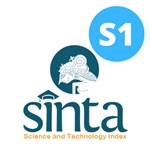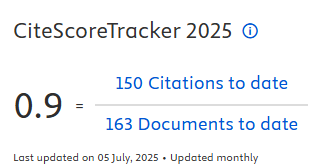The Implementation of Sort, Set in Order, Shine, Standardize, and Sustain as Occupational Accident Preventions at PT X
Downloads
Introduction: The implementation of qualified sort, set in order, shine, standardize, and sustain (5S) is a significant factor to prevent the occurrence of occupational accidents in companies with a high-risk level of occupational accidents, such as being exposed to falling objects or tripped with objects, especially in departments that handle goods or materials. This research aims to identify the enactment of 5S as occupational accidents preventions in the logistic department at PT. X. Metods: This research is descriptive-analytic research which describes the company policy regarding the employment of 5S and the characteristics of the workers in the logistic department at PT. X. Moreover, this research also intends to analyze the strength of the relationship between the workers' characteristics based on the correlation coefficient value by using the cross-sectional approach. The data is in the form of secondary data obtained by using questionnaires and interview. Results: It has been noticed that there is a qualified policy regarding the implementation of 5R in the form of technical instructions and the SOP of the company that has been well-enacted. Majority of the workers in the logistic department at PT. X is between 15-30 years old with high school educational attainment and has been serving in the company for <6 years. It is also perceived that all workers in the logistic department have a good 5S understanding level and good attitudes toward the implementation of 5R. However, there is a difference in the direction of the relationship of the variables analyzed; one is a negative relationship while the other is a positive relationship. Conclusion: It can be affirmed that PT. X has implemented 5S in a good way, seen from the understanding level of the workers regarding 5S or the attitude of the workers in implementing 5S, particularly in the logistic department. This is also proven by the company policy on the enactment of 5S that has been well-carried out.
Keywords: 5S implementation, logistic, occupational accidents
Budiman and Riyanto, A. (2013) Kapita Selekta Kuesioner Pengetahuan dan Sikap dalam Penelitian Kesehatan. Jakarta: Salemba Medika.
Dewi, A. M. (2013) Penerapan Program 5R sebagai Salah Satu Upaya Pencegahan Kecelakaan Kerja di Unit Kerja Administrasi Perencanaan Teknik dan di Unit Kerja Produksi Finish Mill dan Packer PT. Semen Indonesia (Persero) Tbk. Undergraduate Thesis. Surabaya: Faculty of Public Health, Universits Airlangga.
Elyanti, N. (2017) Determinan Perilaku 5R (Ringkas, Rapi, Resik, Rawat, Rajin) pada Perawat Kelas III di RSUD Pasar Rebo Jakarta Tahun 2017. Undergraduate Thesis. Jakarta: Faculty of Medicine and Health Sciences, Universitas Islam Negeri Syarif Hidayatullah.
Geller, E. S. (2001) The Psychology of Safety Handbook. 2nd edn. Boca Raton: CRC Press.
International Labour Organization (2013) Keselamatan dan Kesehatan Kerja : Sarana untuk Produktivitas. 5th edn, Clinics in Laboratory Medicine. 5th edn. Jakarta: International Labour Organization.
Irawan, F. (2011) Penerapan Ringkas, Rapi, Resik, Rajin (5R) di Bagian Produksi dan Administrasi PT. Calvari Abadi Unit Precast Concrete. Undergraduate Thesis. Surabaya: Faculty of Public Health, Universitas Airlangga.
Istianti, J. (2008) Penerapan 5R Sebagai Salah Satu Upaya Pencegahan Kecelakaan Kerja di Bagian Produksi PT. Bintang Terang Gemilang Sidoarjo. Undergraduate Thesis. Surabaya: Faculty of Public Health, Universitas Airlangga.
Kilpatrick, J. D. (2003) Lean Principles. Utah: Manufacturing Extension Partnership.
Ministry of Manpower and Transmigration (2003) Undang-undang Republik Indonesia No. 13 Tahun 2003 tentang Ketenagakerjaan. Jakarta: Kementerian Tenaga Kerja dan Transmigrasi.
National Social Security (2016) Jumlah Kecelakaan Kerja di Indonesia Masih Tinggi, National Social Security.
Notoatmodjo, S. (2003) Pendidikan & Perilaku Kesehatan. Jakarta: PT. Rineka Cipta.
Notoatmodjo, S. (2007) Kesehatan Masyarakat Ilmu dan Seni. Jakarta: PT. Rineka Cipta.
Osada, T. (1995) Sikap Kerja 5S. Edited by M. Gandamihardja. Jakarta: Pustaka Binaman Pressindo.
Pranasution, D. (2015) ‘Analisis Penerapan Metode 5r (Ringkas, Rapi, Resik, Rawat, Rajin) Di PT Bakrie Pipe Industries Melalui Pendekatan Change Management', Jurnal Ilmiah Universitas Bakrie, 3(3), pp. 1–2.
Rahmatullah, B. (2015) Hubungan Antara Karakteristik Individu dengan Tingkat Pengetahuan Penerapan Globally Harmonized System (Studi Kasus di Unit Amoniak PT. Petrokimia Gresik). Final Project. Surabaya: Faculty of Vocational Studies, Universitas Airlangga.
Rochmanto, D. P. (2015) Penerapan Ringkas, Rapi, Resik, Rawat dan Rajin (5R) dalam Upaya Pengendalian Kebakaran di Unit Produksi 2 PT. Kutai Timber Indonesia (KTI). Undergraduate Thesis. Jember: Faculty of Public Health, Universitas Jember.
Sandika, O. D. (2013) ) Implementasi Budaya 5R (Ringkas, Rapi, Resik, Rawat, Dan Rajin) di Unit Machinery and Tool (UMT) PT. Mega Andalan Kalasan. Undergraduate Thesis. Surakarta: Faculty of Teacher Training and Education, Universitas Sebelas Maret.
Septaviani, R. (2012) Faktor-Faktor yang Berhubungan dengan Praktik 5S (Seiri, Seiton, Seiso, Seiketsu, Shitsuke) pada Mekanik Bengkel Sepeda Motor X Kota Semarang. Undergraduate Thesis. Semarang: Faculty of Public Health Universitas Diponegoro.
Setyanto, G. E. (2015) Analisis Penerapan 5R pada Bagian Produksi di PT. Maritim Barito Perkasa. Undergraduate Thesis. Surabaya: Faculty of Public Health, Universitas Airlangga.
Sugiyono (2013) Metode Penelitian Kuantitatif, Kualitatif dan Kombinasi (Mixed Methods). Bandung: Alfabeta.
Suma'mur (1994) Keselamatan Kerja dan Pencegahan Kecelakaan. Jakarta: Gunung Agung.
Suma'mur (2009) Higiene Perusahaan dan Kesehatan Kerja. Jakarta: Gunung Agung.
Wulansari, Y. P. (2009) Penerapan Program 5R sebagai Upaya Pencegahan Kecelakaan Kerja di Boiler dan Turbin Unit 7 PT. IPMOMI-PAITON Energy Probolinggo. Undergraduate Thesis. Surabaya: Faculty of Public Health, Universitas Airlangga.

In order to be accepted and published by The Indonesian Journal of Occupational Safety and Health, Author(s) who submit an article should complete all the review process. The copyright of received articles assigned to the The Indonesian Journal of Occupational Safety and Health and Department of Safety and Health, Universitas Airlangga as publishers of the journal. The intended copyright includes the rights to publish articles in various forms (including reprints).
The Editorial Team of The Indonesian Journal Of Occupational Safety and Health and Department of Safety and Health strive to ensure that no errors occur in the articles that have been published, both data errors and statements in the article.
Users of this website will be licensed to use materials from this website following the Creative Commons Attribution-NonCommercial-ShareAlike 4.0 International License. No fees charged. Please use the materials accordingly.
------------------------------------------------------------------------------------------------------------------------------------------------------------------------------------------
Attribution ” You must give appropriate credit, provide a link to the license, and indicate if changes were made. You may do so in any reasonable manner, but not in any way that suggests the licensor endorses you or your use.
NonCommercial ” You may not use the material for commercial purposes.
ShareAlike ” If you remix, transform, or build upon the material, you must distribute your contributions under the same license as the original.







 How to Submit Articles in OJS
How to Submit Articles in OJS

























